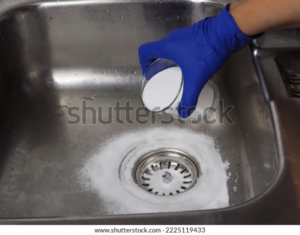Cabinet Painting Sacramento is an easy way to update your kitchen. But it’s a job that requires proper prep to ensure good adhesion and durability.

The first step is to remove the cabinet doors and place them in a garage or other separate workspace. Label each door so that you know where it goes when you reinstall it.
Cabinet painting is a labor-intensive project. It requires emptying and cleaning the cabinets, masking off areas you don’t want to paint, and sanding the surfaces. Thoroughly cleaning with a degreasing solution compatible with your cabinet material helps the new paint adhere properly and provides a more durable finish. Depending on the condition of your cabinets, you may need to fill holes, dents and cracks before priming. You should also clean your brushes and rollers to prevent contaminating the finished product.
The first step in any painting project is a thorough cleaning to remove grease and dirt. Use a liquid degreaser, like TSP, and follow the manufacturer’s instructions to thoroughly clean the surface. This is especially important in a kitchen, where grease, steam and food can accumulate on the cabinet surfaces.
After the cabinets are dry, sand them with fine grit sandpaper to roughen up the surface for proper adhesion and to make it smooth enough for a good coat of paint. Then vacuum the entire cabinet with a soft bristle attachment or use a lint-free tack cloth to get rid of all the sanding dust and debris. If you don’t get this all off, it will waft into the fresh paint and ruin the pristine appearance.
Once the cabinets are sanded, prime them with a good quality latex or oil-based primer, such as KILZ 3(r) PREMIUM Primer, which is designed to provide excellent adhesion and is mildew-resistant for moisture-prone areas such as a kitchen. Using a high-quality primer will prevent stains from bleeding through the new paint, and it will also help the final coat of paint last longer.
When you’re ready to start painting, work on one cabinet at a time, starting with the doors and drawer fronts, then moving on to the cabinet boxes. If you’re just doing a facelift, you don’t need to paint the interiors of the cabinets, so mask off the faces and edges with painter’s tape. If you do decide to paint the interiors, work over a table to reduce the chances of drips and smudges.
Paint
Cabinet painting is a large undertaking that requires an eye for detail. If the job is done incorrectly, the paint may flake or peel with time. To avoid this, make sure your cabinets are in good shape before beginning. It is also important to have a high-quality, professional paint and finish to achieve the best results.
First, choose your cabinet paint color. The options are endless, but a little planning can narrow the field and help you find the perfect color for your cabinets. It’s important to consider the amount of natural light the room receives as well as its direction. Some homes have bright south-facing sunlight that makes colors look vibrant, while others have cooler north-facing light that can make them look drab or cold.
Next, prime the cabinets. Many products include a primer in the formula, but if yours does not, you will need to apply one. Be sure to follow the instructions on your primer, and allow it to dry thoroughly before applying a second coat. During this process, you can also label where the cabinet doors go so they are easy to reinstall. If a door rail butts into a stile, paint the rail first and then carefully paint the stile before it dries.
When it comes to finishing the project, professionals recommend taking extra care when sanding and cleaning. They suggest using a spray-on degreaser to remove any grease, oil, or dirt, and then lightly sand the surface to prepare it for a new coat of paint. It’s also a good idea to use a dust mask to protect your respiratory system while sanding and painting.
Once your cabinets are ready to be painted, apply a thin layer of paint with a foam roller and then touch up the corners and edges with a soft-bristled brush. A light sanding after the paint dries will also improve the appearance and smoothness of the finished product.
Once the cabinet paint has dried, you can reinstall the doors and drawer fronts and add any other hardware. Be sure to let the finished product dry completely before handling it, and use gloves when reinstalling the handles to prevent fingerprints from transferring to the new surface.
Hardware
Cabinet hardware is a major component of your kitchen’s overall look. It not only complements the color of your cabinets, but it also helps doors and drawers open and close softly and easily. There are many options for cabinet hardware, from handles and knobs to hinges and slide rails. Whether you choose wood, metal or plastic, your choices can make a big difference in the appearance of your kitchen.
Before you paint your cabinets, it’s important to consider the type of hardware you want to use. Metal and wood are both popular choices for cabinet hardware, but each has its own advantages. Metal hardware tends to be more durable, and it’s easy to clean. Wood hardware, on the other hand, can add a warm and cozy touch to your kitchen.
Another factor to consider when choosing cabinet hardware is the finish of your cabinets. You should always select a semi-gloss paint, as it’s more resilient to scratches and is easier to wipe down. Additionally, a glossy finish reflects light better than an eggshell or satin finish.
If you’re unsure about what type of finish to choose, talk with your local home improvement store. They’ll be able to recommend the best option for your cabinets.
There are several different types of paint you can use for your cabinets, but oil-based is the most effective. It will provide a smooth, even finish and help the new coat of paint adhere well to the surface. You can also use latex paint for your cabinets, but it’s important to thoroughly prep the surface first. Latex paint doesn’t stick as well to wood surfaces, and it will show variances in the texture or grain of the wood.
One of the most common mistakes people make when painting their cabinets is not using the correct primer. Primer is like the glue layer that connects your paint to the cabinet, and without it, your paint won’t stick. If you skip the primer, you’ll end up with uneven and chipped cabinet paint.
Once you’ve finished painting your cabinets, it’s time to reinstall the hardware. Before you do, be sure to label each door and drawer with its corresponding number and location. This will ensure you don’t mix up the hinges or screws when it comes time to reinstall them.
Finish
If you’re going with a stain finish, be sure to choose one that’s durable and can stand up to moisture. Stains also tend to last longer than paint. If you’re going with a clear finish, make sure that it is water-based or, better yet, a water and oil hybrid so that it can be easily cleaned with soap and water (as opposed to mineral spirits which must be dissolved).
You may want to consider choosing a semi-gloss or high-gloss formula for your cabinets. This will provide a more reflective surface, making your kitchen look brighter. A glossier finish is also easier to wipe down, which is important in a busy kitchen.
When choosing a color for your cabinets, be sure to factor in the amount of natural light that is coming into the room and what direction it is facing. Some light sources can produce a lot of heat, which can cause the color to look warmer or more yellow, whereas other types of light can produce a cooler hue, making it look more blue or green.
As a general rule, it’s best to choose warm, neutral or earth-toned colors for your cabinetry. These colors are universal and can be paired with just about any other shade. For a bolder look, try using an accent color such as red or orange to add some pop to your cabinets.
Once your cabinets are ready to be painted, you can either use a sprayer or foam rollers and brushes. If you opt to use a sprayer, make sure that it’s set up properly before starting and be certain to wear a respirator mask for indoor painting.
For a smooth finish, it’s important to prep the surfaces before applying the primer and then the paint. First, lightly scuff the surface of the cabinetry with 150-grit sandpaper or a sanding sponge and then clean it thoroughly with a damp cloth to remove any dust.
Next, apply the primer to the cabinetry. Then, if you’re going with a water-based product, apply the coats of paint as directed. If you’re going with an oil-based product, follow the instructions for soaking your brushes in solvent before beginning.








